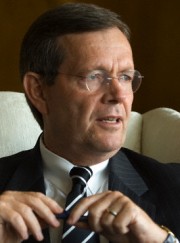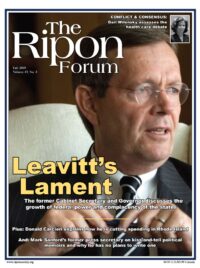 Health care reforms being considered by Congress constitute another massive expansion of federal power. Washington has become a runaway train.
Health care reforms being considered by Congress constitute another massive expansion of federal power. Washington has become a runaway train.
The legislation perpetuates and accelerates a century-long emaciation of state governments. The legislation also expands a relationship where string-laden dollars are “given” to states (and the people) in a manner that makes Congress a federal puppeteer who names the tune and calls the dance.
Our nation’s framers envisioned a federal government with supreme powers, but limited and enumerated duties. Operation of the health care system (like so many other areas Congress now controls) was not one of the enumerated duties.
The drafters of our Constitution knew that left unchallenged, the federal government would slowly but surely become more and more intrusive. I wonder if they could have imagined that the federal government would someday have a Health Choices Administration, or mechanisms to decide who gets care, where it can be provided, or how much it will cost.
They provided a safeguard by encouraging the strength of the states. In fact, as a condition of ratification, the 10th Amendment was inserted which specified that powers not specifically granted to the federal government would remain with the states and people. During debate over this Amendment 300 years ago this past summer, James Madison said, “…the state legislatures will jealously and closely watch the operations of this government and be able to resist with more effect every assumption of power than any other power on earth can do.”
Rather than the strong political counterbalance to the federal government, states have become anemic supplicants, going to Washington with their hands out, pleading for more federal tax money. Without steady counter pressure from unified states, the momentum of Washington’s budget, influence and arrogance will inevitably grow.
The history of the states’ slow constitutional atrophy since that time has been well documented. They have become a shadow of the full-players envisioned by the founders. Rather than the strong political counterbalance to the federal government, states have become anemic supplicants, going to Washington with their hands out, pleading for more federal tax money. Without steady counter pressure from unified states, the momentum of Washington’s budget, influence and arrogance will inevitably grow.
An Outrageously Bold Plan
There was a moment in 1993-1994 when states showed at least faint signs of a constitutional pulse. The anti-Washington energy pulsing from the health care debate at that time built upon frustration about entitlement programs and other federal mandates. States were frustrated and felt they were losing control of their budgets and their freedom to act.
An unusually bipartisan movement began to organize among elected state government officials. They concluded to convene a Conference of the States which would be a means of formalizing their discontent and advancing an agenda to rebalance the distribution of power.
Under their plan, each state would, by resolution, pass in their state legislature a resolution appointing delegates to attend this first ever Conference of the States. At the meeting, delegates would devise a set of proposals which might have included proposed constitutional amendments or federal legislation that would slow the one way flow of power and money to Washington.
There was a moment in 1993-1994 when states showed at least faint signs of a constitutional pulse.
Once the Conference of the States had devised a bill-of-particulars, called a “states petition,” each state would be asked to ratify it. When 34 states had done so, the states would collectively gather in Washington to formally present their demands. The confrontation, it was thought, would force the people to engage.
Looking back, it was an outlandishly bold plan. But how else could the momentum of federal expansionism be altered? How else could Congress be made to hear unless there was an unmistakable expression of the people’s will?
Ben Nelson, then the Democrat Governor of Nebraska, and I, the Republican Governor of Utah, chaired the effort. Jointly, the National Governors Association, the National Council of State Legislatures, Council of State Governments and the State Legislative Leaders Foundation formally approved the plan.
State leaders met regularly to strategize and organize. The emergence of this movement was covered widely by national, regional and state media. In December 1994 the Washington Post wrote about the discontent felt among the states and the formation of the Conference of the States. It said, “Instead of complaining, the governors and legislatures want to come to Washington with the power to bargain. The project is on a fast track.”
Organizers anticipated it would take two years for enough states to ratify the proposal so that the Conference of States could then pull the trigger. The first year many states passed it through both houses of their legislature. Others passed it through one chamber but awaited action in the other.
As more states debated and passed the resolutions, media attention grew. A genuine organized protest was beginning to take shape. The movement had legs.
Naturally, opposition began to grow as well. In the summer of 1994, two things happened to alter the movement’s momentum. An unlikely coalition of groups from the far right and far left began to actively oppose enabling resolutions in state legislatures. Groups with a far right philosophy argued (without factual basis) that the Conference of the States would morph into a constitutional convention. On the left, labor unions seized on the same rhetoric and began claiming the meeting would result in all types of constitutional mischief like outlawing abortion, etc.
This unholy coalition reached legislative hearing, loud and controversial. State legislators, up for re-election in November of that year, became weary of mobilizing a new group of opponents.
The most significant momentum shift came with the Republican takeover of Congress in the 1994 mid-term elections. Ironically, the election was a direct expression of frustration with the direction of the federal government.
The sweeping power shift brought about by the 1994 election made the Republican Governors Association meeting in Williamsburg, Virginia a historically significant event. Just ten days after the election, Speaker-Elect Newt Gingrich and the new Senate leader Bob Dole brought their respective leadership teams to the conference to meet with Republican Governors.
I was made chairman of the Republican Governors Association at that meeting. It had been my duty to organize the meeting and six months earlier, in keeping with my work on the Conference of the States, I made the decision to theme the conference on the need to rejuvenate Federalism.
At that meeting, in that historic place, returning power to states became a primary theme of the party’s governing agenda. Republican governors where asked by the new Congress to become their partners in retooling the nation’s welfare and Medicaid systems. The plan was to devolve power to the states.
As the new legislative agenda unfolded, those of us who had organized the Conference of the States could see momentum had shifted in a direction we approved of, but in a fashion different than we had anticipated. We recalibrated the Conference of the States effort into a far less grand vision, wrapped it up, and focused our energies on legislative proposals which would return more control of the nation’s welfare system and Medicaid to state control.
Two years later, welfare reform had passed. Medicaid reform was jettisoned in a compromise to get welfare reform. Later, Congress also passed unfunded mandate legislation. With those modest outcomes, the resurgence of federalism quietly returned to hibernation.
Federalism for the 21st Century
Since the Conference of the States movement shot across the evening sky of history, I have spent ten more years as Governor of Utah and five years in the President’s cabinet. Both experiences intensified my view that a strong but limited federal government is needed. It has also made me absolutely sure that states are a vastly superior place to conduct most of the domestic affairs of government.
Looking back on the Conference of the States I occasionally wonder what would have occurred had efforts to make long term structural change not been interrupted by the sweeping change of the 1994 election. Welfare reform was good policy and an important victory, but it was a modest and short term resurgence of federalism. Rebalancing will require more than legislation. It will require structural change brought about by a determined citizenry.
We live in an era where speed and innovation are a requirement of leadership in a global economy. A 21st century version of federalism would be a dynamic form of government. In such a government, for example, universal access to health insurance could be achieved more quickly than it will be at the federal level.
Congress would establish national standards and the needed tools. States, within a specified time period, would accomplish the task or suffer loss of federal financial support. Different states would go about it in different ways, but the outcome would be more in line with the attitudes and beliefs of the American people. States are closer to the people.
Yes, our country is again engaged in a debate over health care reform. When Congress went home for its August recess, they were met by angry citizens. How angry? Will there be a watershed shift as there was in 1994? If there is, it will not be because of health care reform. Rather, it will be because people are wary of Washington having too much control.
Water will run uphill before Congress will voluntarily give up power.
Rebalancing the division of labor between the state and federal government will require more than legislation. It will require a determined citizenry and bold leadership from the states. Will there ever be a Conference of the States, or some other organized effort to jolt the federal government back into place? It is hard to know.
However, if there isn’t, our national government and its unbridled debt will continue to grow. Water will run uphill before Congress will voluntarily give up power. The founders of our country knew that, and we should too.
Michael O. Leavitt served as Secretary of the U.S. Department of Health and Human Services from 2005 to 2009, and as Administrator of the U.S. Environmental Protection Agency from 2003 to 2005. Prior to that, from 1993 to 2003, he served as the Governor of Utah.




